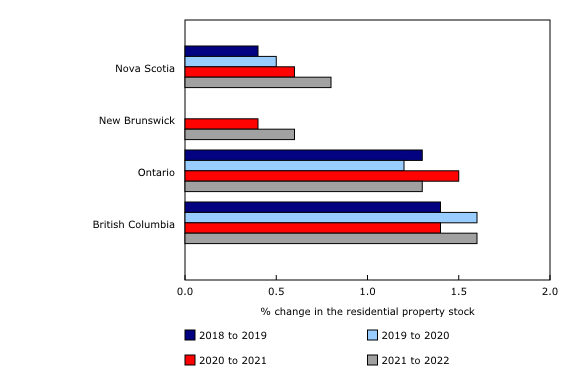Canadian Housing Statistics Program: New residential properties, 2022
Released: 2023-10-12
Preliminary estimates from the Canadian Housing Statistics Program show that from 2021 to 2022, the residential property stock—all residential properties, excluding vacant land—grew by 1.3% in Ontario, slower than the 1.5% rate of growth from 2020 to 2021. In the Toronto census metropolitan area (CMA), the stock of residential properties grew by 1.7% (representing 29,905 net new properties) from 2021 to 2022, compared with 1.9% (+33,520 net new properties) from 2020 to 2021.
Growth in the stock of residential properties from 2021 to 2022 accelerated to 1.6% in British Columbia, compared with 1.4% from 2020 to 2021. In the Vancouver CMA, the number of residential properties grew by 2.1% (+16,705 properties), compared with 1.6% (+12,945 properties) in the previous period.
Preliminary data for the 2022 reference year are available at the CMA and the census agglomeration level for Newfoundland and Labrador, Nova Scotia, New Brunswick, Ontario, British Columbia, and the Northwest Territories. Further detailed information on the characteristics of residential properties for all provinces and territories, except Quebec, will be released at a later point. Preliminary data are subject to revision.
Note to readers
The unit of analysis for this release represents residential properties rather than dwellings. Residential properties include all land and structures intended for private dwelling purposes. The Canadian Housing Statistics Program (CHSP) provides information on the residential property stock, defined here as all residential properties in a given geographic region, excluding vacant land. A residential property may consist of one or multiple dwellings. Single-detached houses, for example, usually consist of only one dwelling, while properties with multiple residential units can include many dwellings.
Data for Newfoundland and Labrador and the Northwest Territories are not available at the provincial or territorial levels. Similarly, data by property type are not available for this province and this territory. Therefore, Newfoundland and Labrador and the Northwest Territories are not analysed in this release.
For the 2022 reference year, the methodology for identifying property type in New Brunswick and British Columbia has improved. Consequently, users are advised to limit comparisons of property types between 2021 and 2022.
Geographical boundaries
The CHSP disseminates data based on the geographical boundaries from the Standard Geographical Classification 2016.
The CHSP database does not contain information about residential properties on reserves.
Contact information
For more information, or to enquire about the concepts, methods or data quality of this release, contact us (toll-free 1-800-263-1136; 514-283-8300; infostats@statcan.gc.ca) or Media Relations (statcan.mediahotline-ligneinfomedias.statcan@statcan.gc.ca).
- Date modified:


